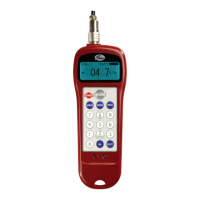8
“POWER” key again until the meter turns off. Now turn the meter on for
normal operation. Data entered into the unit must still be in SI units of
millimeters and grams.
The capacity available for output is 99,900 Pounds force, Kilograms
force, or Newtons.
Frequency Display
F =
h h h h
Hz
Pressing the “Hz” key toggles the LCD display output between tension,
frequency, or both.
Measurement Errors
If either the calculated belt tension or measured frequency cannot be
displayed the red LED light will turn on and the LCD screen may display
“ERROR”. If an error has been made in the measurement, “ERROR”
will be displayed. Check the accuracy of the mass constants, width and
span values and retry the measurement until a tension or frequency
value is displayed. With the auto-trigger feature it is not necessary to
press the “Measure” key again.
When a tension or frequency reading is obtained, take at least two
additional readings for comparison. Three readings in relative close
proximity indicate reasonably accurate belt tension readings.
Tension measurements made on belts at very low tensions may yield
greater variability and a greater probability for errors. If a tension reading
cannot be obtained, the belt may be too loose to generate a clear
harmonic frequency signal. If this is the case, the belt may need to be
tightened in order to obtain a tension reading. The optional Inductive
Sensor is more effective at very low frequencies than the conventional
microphone sensors, and may provide better results.
NOTE: Frequency only readings must have data values in the storage
registers or the meter’s red LED light will stay on.
Battery Gauge
A battery graphic is located in the upper-right hand corner of the LCD
screen. This gauge provides an estimate of the remaining battery power.
A dark filled graphic indicates a full charge. When the battery level
becomes critically low, the meter indicator as well as a “Low Batt”
message both blink.
SonicTensionMeter_Manual_4_14.indd 8 4/26/14 9:09 AM

